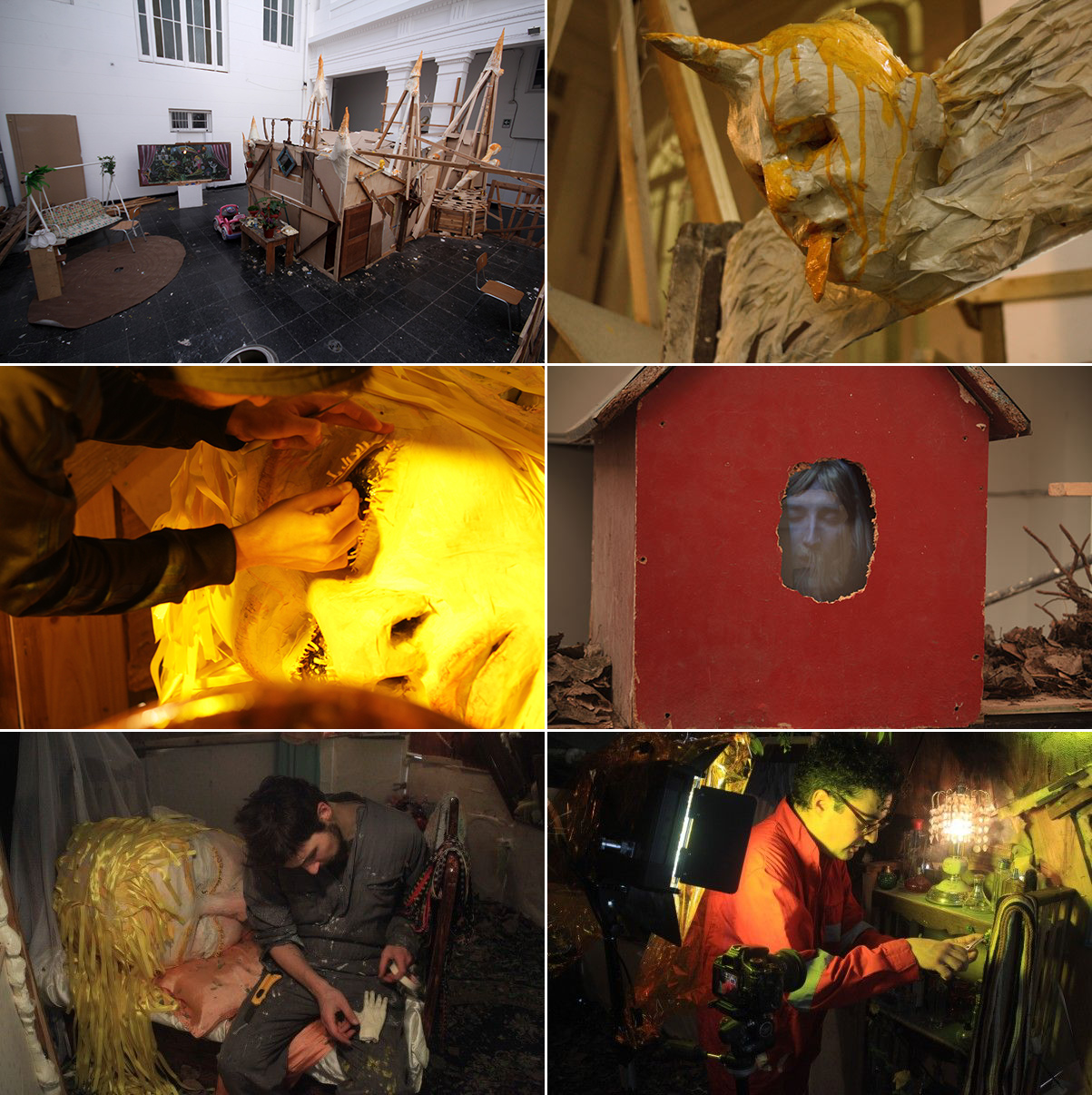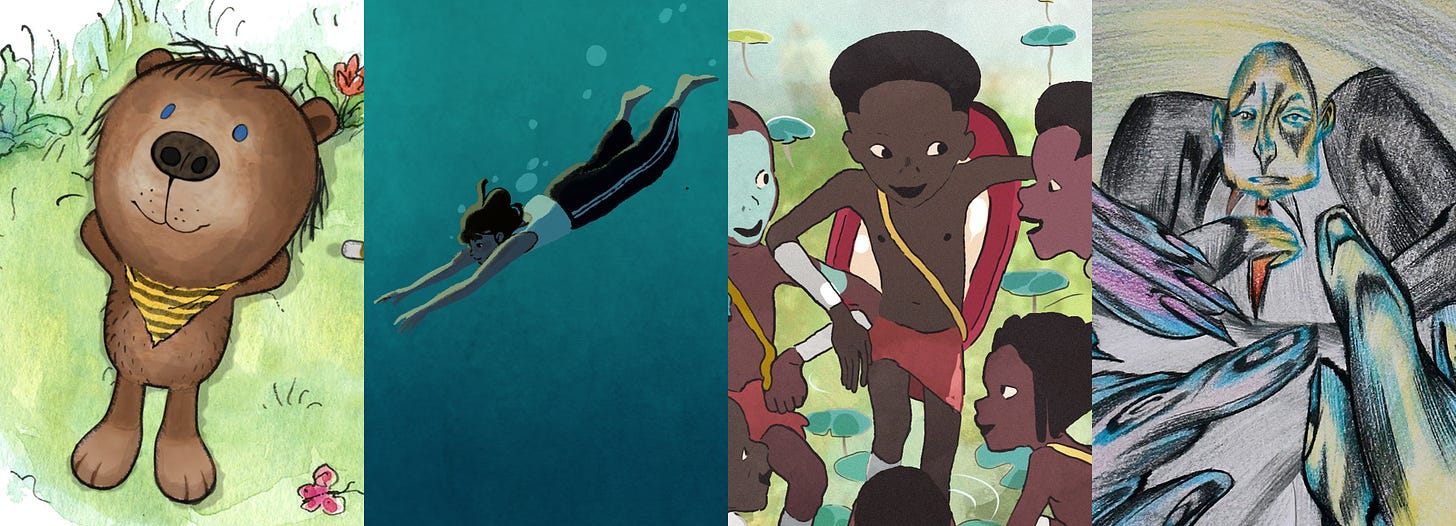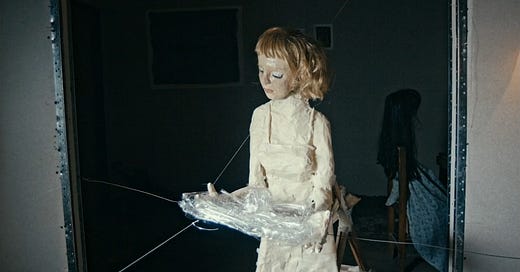Welcome! Today’s issue of the Animation Obsessive newsletter goes like this:
1️⃣ Animating the horror of The Wolf House.
2️⃣ News from the world of animation.
3️⃣ [MEMBERS] Looking at Cowboy Jimmy, the famous Yugoslav cartoon.
Not signed up yet? It’s free to receive our Sunday issues in your inbox:
Now, here we go.
1. Houses in motion
The Wolf House isn’t a typical horror film. It doesn’t hinge on murder or shock. This indie feature from Chile, released in 2018, gets under your skin with off-ness. And it might be the most unsettling work of animation we’ve ever seen.
If you’re not familiar with The Wolf House, it claims to be a creation of Colonia Dignidad — a Nazi-affiliated cult that used to exist in real-world Chile. It tells a cautionary tale about an escaped cultist named Maria, who hides in an abandoned house with two pigs and enters a kind of mental hell. Uncomfortable stuff, but the visual experience is even darker.
There’s no great way to describe the animation in The Wolf House. This is a seething world, where everything comes undone and tries to fix itself. The house and its occupants bleed together. Someone will appear as paint on a wall, then be erased, then be reborn out of furniture as a mound of tape and cardboard — all in 30 seconds.
It’s a visual nightmare that continues, without a single cut, for over an hour.
Animator-directors Cristóbal León and Joaquín Cociña didn’t have traditional horror in mind. “We try to make, kind of, comedies,” León once said, at least half-seriously.1 They didn’t have traditional animation in mind, either. These Chilean artists, who are very much not tied to Colonia Dignidad, were creating their own sort of stop-motion. They made it up themselves.
León and Cociña animated most of The Wolf House alone. It was a five-year process — more when you count the planning stage. They broke every rule of animation along the way.

“The Wolf House is not so much about naturalistic movement, like animation imitating nature,” León explained, “but is more about the destruction and construction of images.”
Its roots go back to Universidad Católica, where León and Cociña met as art students in the 2000s. They were only acquaintances when they started to experiment with video projects together. León had some background in animation, but Cociña had none. Yet they landed on a new idea. By photographing their process as they drew and sculpted, they could make a film that documented its own creation. That film was Lucia (2007).
“With Lucia, the process was the piece,” Cociña said. “So, that was like a revelation for me.”
They transformed their workspace into an ever-evolving artwork, animating at human scale — just like in The Wolf House. It’s a personal style, invented almost as a form of video art. In fact, Lucia wasn’t fully meant as an animated film at all.
“We thought of that short for the art world,” León said. “We didn’t have the world of cinema on our radar yet ... It only started to happen that the short had a life in the world of film festivals.”
Lucia isn’t as inventive or assured as The Wolf House, but its look is remarkably similar — it’s a bizarre stop-motion film where drawing, sculpture and found objects tell a horror story. Their art practice had led them to animation in a roundabout way. Here’s how Cociña explained it:
I think, in a way, our works became films, and that’s why we became animators and filmmakers. It’s not that we were planning to do that. We are both from the visual art field … We basically became, slowly, filmmakers and animators through the work. So, when we started to make Lucia, the first short film, which we made together with [Wolf House Producer] Niles Atallah … we had this vague idea to have a piece where drawings were taking over a room. And we did that and, during the process, I personally realized, “Oh, we are doing something that can be called animation!”
The Wolf House is a successor to Lucia. Originally, it was planned as the third part of a trilogy of shorts in this style — Luis (2008) was the second one. But The Wolf House started to grow in scale. By early 2009, its script was being developed into a feature-length film. It wouldn’t premiere for almost 10 years.

The Wolf House was a wildly unorthodox production. León and Cociña animated in a self-contained, moveable workspace, improvising the whole way. “We had a script from the beginning,” León said. “But that script kept changing, always, during the five years of production. We didn’t respect the script.”
That was by design. According to León, even the storyboard for the film was:
… not really a storyboard, because storyboards normally describe every scene shot by shot. In this case, it was more like… I’d compare it to a children’s book. You have like 20 images, and you have a whole story told in these 20 images. And it was something like that — we had like 20 or 25 images that told the whole story. Every one of those images is a scene in the film. So, we imagined the making of the film as the destruction of one of those images and the construction of the next one.
The production was tooled to keep this creative process interesting for León and Cociña. Whenever they got bored, they could change whatever they wanted.
The Wolf House had influences in film, especially David Lynch and The Way Things Go (1987), but it’s first and foremost a series of freely built and destroyed artworks. León said that the “best paintings and sculptures” they’d ever made were captured in single frames of this film, rushing by. Cociña said that “eighty percent” of the scenes reached a point where the duo disliked them and did something extreme — mangling sculptures and painting the workspace black.
It was a freedom so great that it risked, over the yearslong production, turning the film into a mess. So, just before animation began, they drafted “ten commandments” for The Wolf House. León called them the core guidelines for the film’s animation:
This is painting on camera.
There are no puppets.
Everything can be transformed as sculpture.
It doesn’t go to black.
Continuous shot.
The film TRIES to be normal.
Color is symbolic.
Maria is beautiful.
The camera position is never the same from frame to frame.
It’s a workshop, not a set.
These rules steered their work from the beginning, and helped to keep the improvisation in line. They ensured that The Wolf House had a single soul throughout. “We think of our films like sculptures or like paintings or drawings,” León said, “and we wanted this film to be like one piece, you know? Like one current of energy, one stream of matter.”

What wasn’t consistent, though, was León and Cociña’s location. They didn’t want to be isolated in the studio for years as they made The Wolf House — and galleries and museums kept offering to exhibit their work.
So, after around six months of production, they decided to try something new. They exhibited the workspace for The Wolf House as they created the film inside it, turning their own animation process into an art installation. As León put it, they chose to:
… move our studio, with all the chaos, and all the dirt, and all the accidents that that means. And we did it and it was a really great experience, and it also transformed the production of the film. We had a lot of spontaneous assistance animating the film. Some people came to the exhibition and asked, “What are you doing?” And we said, like, “We are doing this stop-motion film. Do you want to come in?” And some of them stayed five minutes animating; some of them stayed for like two months animating with us.
León and Cociña would move to twelve locations, mostly in the city of Santiago. But they also went abroad, showing in museums and galleries in Argentina and the Netherlands. It served an artistic purpose and a practical one: The Wolf House relied on Chilean grants and funds — and it now qualified for film subsidies and art subsidies.
It was just more of the wholly original process that created the animation for The Wolf House. The film feels so unfamiliar in part because it was made in an unfamiliar way.
The directors’ personal style defines The Wolf House — the improvisation and collaboration, the strange materials and stranger working conditions. The process is the piece. And it won the film a fanbase much larger than León and Cociña expected. This unsettling work, so tied to Chilean history, is now an international cult classic.
If you haven’t seen The Wolf House yet, it’s streaming for free on Tubi.
2. Animation news worldwide
Pitch markets hint at what’s coming next

In the United States, major studios dominate animation. Not so in Europe, where a vast, almost unfathomably complex network is in place to support smaller-scale animated film and TV. It involves things like grants and tax shelters — and presales, co-productions and other key financing.
A growing number of events in Europe power this network. As we’ve written, the deals happen here. And a bunch of them are underway right now.
Take the all-important Cartoon Forum in Toulouse, France. Animation Magazine reports that “80 projects of animated TV series were presented this year from 19 European countries.” Maybe the biggest winner was Germany’s Tiger and Bear, adapted from a children’s book series by German illustrator Janosch, now 91.
As Ben Croll wrote for Variety:
… the upper-preschool project saw nearly 60% buyer attendance at its Tuesday pitch and fielded effusive feedback from American, British and Scandinavian broadcasters in the days that followed — with many keying to the project’s laid-back tenor.
Other hyped book adaptations at Cartoon Forum this year included Shepherdess Warriors, Louca and Mekka Nikki, all based on Franco-Belgian comics.
Elsewhere, we have Czechia’s upcoming CEE Animation Forum. Zippy Frames explains that it will host 49 pitches this year. Among them are the feature films The Island of Salamanders by French director Catherine Maximoff and The Helpers by Poland’s Betina Bożek.
On Instagram, Bożek shared concept art for her film and wrote that it’s “been developing for two years.” Now, she’s looking to secure the money to make it real. The Helpers is intended to be “entirely hand-drawn with crayons,” and it has a one-of-a-kind plot outline about:
… a deeply frustrated clerk who sacrifices all time and energy in his work. In his restless everyday life, he is not aware of the existence of the helpers, who make the clerk’s life easier by helping his jaw to stay in the same place while he’s sneezing or keeping his body on the surface of the water while swimming.
And that’s only the start. The Weird Market in Spain just wrapped (see Cartoon Brew’s coverage), and there’s a new animation pitch event in Italy at the MIA market. Two notable projects there are Sidi Kaba and the Gateway Home, a feature film by Rony Hotin, and Flydog by the Italian studio Movimenti (Tear Along the Dotted Line).
Best of the rest
Have you seen the reveal trailer for My Father’s Dragon? The Irish feature, directed by Nora Twomey (The Breadwinner) at Cartoon Saloon, is due November 11.
In America, Laika is continuing its Laika Archives series. There’s now a playlist on its YouTube channel.
British writer Alex Dudok de Wit, who translated Shuna’s Journey and wrote the definitive English study of Grave of the Fireflies, is joining animation himself. He tweets that he’s becoming “a production manager on the feature Ghost Cat Anzu.”
In America, David Zaslav rejects the idea that Warner Bros. Discovery could sell to Comcast. “We are not for sale, absolutely, not for sale,” he says. Vanity Fair cites persisting uncertainty over the future of his company.
Festival BAB in Slovakia begins October 3. It seems to be streaming its selections this year via DAFilms.
In Japan, there’s another stunning sign of the ground that franchise films have gained over original features: One Piece Film: Red has dethroned Ponyo at the box office, becoming Japan’s sixth-biggest anime film.
You’ve heard that Russia is “partially mobilizing” — essentially, drafting soldiers. Now Sergey Selyanov, a powerful producer, is asking the Kremlin for a draft exemption for “all companies producing and distributing audiovisual content.”
Meanwhile, the Russian Film Academy won’t submit to the Oscars this year. The head of the Russian Oscar Committee resigned in protest.
Lastly, the CEE Animation Workshop is open for applicants. If you’re involved in animation in one of the (many) qualifying European countries, it offers mentorship and other critical support. The deadline is October 24.
3. Quick look back — Cowboy Jimmy
Keep reading with a 7-day free trial
Subscribe to Animation Obsessive to keep reading this post and get 7 days of free access to the full post archives.



